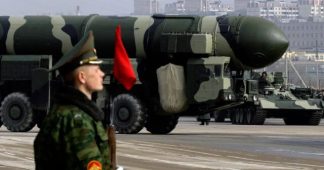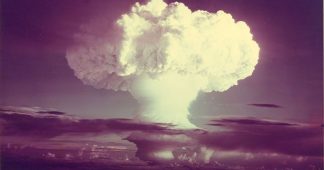By Andre Damon
The US military published three strategic documents Thursday outlining plans for conflict with China and Russia and declaring that nuclear weapons form the “bedrock” of US military strategy.
The publication of the National Defense Strategy, the Nuclear Posture Review and the Missile Defense Review comes less than two weeks after the Biden administration published its National Security Strategy, which pledged that the United States will “win” in conflict with Russia and China in what it called a “decisive decade.”
The documents double down on the fundamental assertions of the Trump administration’s 2018 National Defense Strategy, which declared that “inter-state strategic competition, not terrorism, is now the primary concern in U.S. national security.”
Introducing the National Defense Strategy, Defense Secretary Lloyd Austin called China America’s “pacing challenge” while Russia was an “immediate and sharp threat.”
Austin said China remains the one adversary “both with the intent to reshape the international order and increasingly the power to do so.”
The National Defense Strategy calls China the “most comprehensive and serious challenge to U.S. national security,” and the Nuclear Posture Review asserts that “by the 2030s, the United States will, for the first time in its history, face two major nuclear powers as strategic competitors and potential adversaries.”
Commenting on the significance of the documents, the Atlantic Council made clear that the documents’ references to “conflict” should be understood as references to “kinetic conflict”—i.e., shooting war.
Combined with the emphasis on “Campaigning,” it sends a strong message that the world is actively contested now, and that the Department of Defense (DOD) and all of the US government is not just preparing for potential kinetic conflict, but engaged already in active contestation focused on China, and secondarily Russia.
The NDS’s focus on “Campaigning” will signal that DOD and other US departments are already conducting operations to disadvantage China—tantamount to a new Cold War. The era of DOD claiming that its activities—freedom of navigation operations, reconnaissance flights, multilateral exercises—are merely “things we have always done” is over.
In March 2020, as he was campaigning for president, Biden promised to repudiate the “first use” of nuclear weapons, writing, “I believe that the sole purpose of the U.S. nuclear arsenal should be deterring and, if necessary, retaliating against a nuclear attack. As president, I will work to put that belief into practice, in consultation with the U.S. military and U.S. allies.”
Biden’s nuclear strategy document not only rejects that view, but positively articulates a sweeping view of nuclear weapons as forming the “bedrock” of US military strategy.
The document, according to the US Defense Department’s fact sheet:
recognizes that nuclear weapons undergird all our national defense priorities and that no element of U.S. military power can replace the unique deterrence effects that nuclear weapons provide. Although the fundamental role of U.S. nuclear weapons is to deter nuclear attack, more broadly they deter all forms of strategic attack, assure Allies and partners, and allow us to achieve Presidential objectives if deterrence fails.
In other words, the United States reserves the right to use nuclear weapons to respond to a non-nuclear attack, blurring the lines between “conventional” conflict and nuclear war.
In the Defense Department briefing, this point is elaborated. The NPR, a department official stated, “establishes a strategy that relies on nuclear weapons to deter all forms of strategic attack. This includes nuclear employment of any scale, and it includes high-consequence attacks of a strategic nature that use non-nuclear means.”
The publication of the document was rapidly condemned by arms control experts. “The Biden administration’s unclassified Nuclear Posture Review (NPR) is, at heart, a terrifying document,” wrote the Union of Concerned Scientists (UCS).
“It not only keeps the world on a path of increasing nuclear risk, in many ways it increases that risk,” the UCS argued, by claiming that “the only viable U.S. response is to rebuild the entire U.S. nuclear arsenal, maintain an array of dangerous Cold War-era nuclear policies, and threaten the first use of nuclear weapons in a variety of scenarios.”
The organization continued:
The reality is, one phone call from the president and the issuing of a code shorter than a tweet could lead to the launch of hundreds of nuclear-armed missiles in less than five minutes, which would hit their targets in less than one-half an hour with warheads twenty times more destructive than the bomb that destroyed Hiroshima.
While in fundamental continuity with Trump’s national security strategy, the document repudiates the rhetoric used by the Obama administration’s 2010 national defense strategy. As the New York Times writes of the Pentagon’s nuclear strategy,
But its contrast to the last document issued by a Democratic president, Barack Obama, is stark. Mr. Obama’s strategy—first issued in 2010 with Mr. Biden, who was the vice president at the time—aimed to drastically diminish the role of nuclear weapons in U.S. defenses and focused much of its attention on keeping nuclear material out of the hands of terror groups. At the time, China and Russia were considered full partners in the effort to contain North Korea’s nuclear arsenal and dissuade Iran from building nuclear weapons.
In its introduction, the National Defense Strategy asserts that the US military “will focus on safeguarding and advancing vital US national interests,” which include America’s “economic prosperity.”
This marks a significant development from Trump’s 2018 National Defense Strategy, which largely referred to the use of military force to secure economic interests in the negative—asserting that it was China that was doing so. While this was the clear implication of the 2018 document, the definition of “national interests” advanced by the Pentagon’s 2022 document to include “economic prosperity” constitutes an even more open step toward advocating the doctrine that war is an acceptable means to secure economic aims.
These documents, which were not seriously discussed in the US media, make clear the fundamental falsehood that the massive US military buildup this year is a response to “Russian aggression.” In reality, in the thinking of the White House and Pentagon war planners, the massive increases in military spending and plans for war with China are created by “dramatic changes in geopolitics, technology, economics, and our environment.”
These documents make clear that the United States sees the economic rise of China as an existential threat, to be responded to with the threat of military force. The United Staes sees the subjugation of Russia as a critical stepping stone toward the conflict with China.
excerpt from an article at www.wsws.org
We remind our readers that publication of articles on our site does not mean that we agree with what is written. Our policy is to publish anything which we consider of interest, so as to assist our readers in forming their opinions. Sometimes we even publish articles with which we totally disagree, since we believe it is important for our readers to be informed on as wide a spectrum of views as possible.











